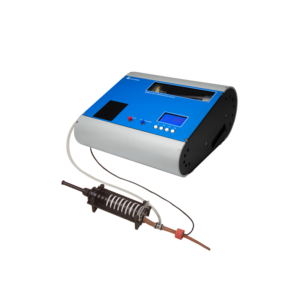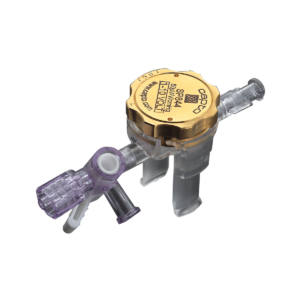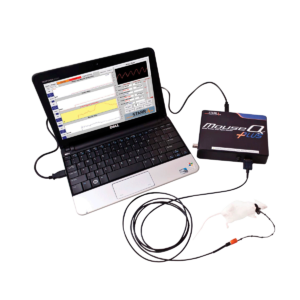Blood pressure
Blood Pressure Recorder - Non Invasive

Background
Non-invasive techniques are in line with the principles of the Three Rs (Replacement, Reduction, Refinement) in animal research. By using non-invasive methods, researchers can obtain valuable data without resorting to more invasive procedures, reducing animal distress and the number of animals needed for experiments.
Ugo Basile, as a manufacturer of preclinical research instruments, provides specialized tools that are designed to accurately and reliably measure non-invasively blood pressure in small animals, aiding researchers in obtaining high-quality data for their studies.
Invasive blood pressure measurements are not applicable to many areas of cardiovascular research, as many diseases and conditions, such as hypertension, heart disease, and stroke, are closely linked to changes in blood pressure, when its measurement requires surgical intervention. Researchers need accurate and non-invasive methods to study these conditions in animal models to better understand their mechanisms, progression, and potential treatments.
In addition to what described above, invasive methods frequently require anesthesia, which affects blood pressure, cause stress and influence experimental outcomes, Limiting the translational value of the studies. Moreover, animal welfare and ethical considerations are more and more important, as well as limiting the risk of complications such as infections, tissue damage, bleeding.
From the accuracy standpoint non-invasive methods are more adaptable to the different animal sizes variation and their versatility allows to compensate also for anatomical differences.
Multi function, non-invasive recorder
A reliable pressure generator, provides smooth and stepless pressure build-up.
A “Riva Rocci sphygmomanometer” provides a precise recording of the systolic and diastolic blood pressure. It works by transmitting pressure to the tail cuff to obtain accurate systolic and diastolic pressure readings that are digitally presented in 10 mm Hg steps. The animal pulse rate can be assessed in real time by a pulse rate counter, which picks the signal from the pulse transducer.
The Ugo Basile non-invasive Blood Pressure system combines functionality of multiple systems in a single turn-key, stand-alone solution thanks to:
- A pressure generation-pressure monitoring system
- A pulse amplifier
- A thermal-array analog and digital recording unit
- Pulse rate measuring and recording
- Microprocessor controlled functions to self-diagnosis, calibration, signal filtering, signal storage.
- Wide range of tail transducer sizes (4-18 mm) adapts to small to medium sized animals (mice-dogs).
- Internal memory and PC output (BNC already amplified).
- Can be connected to popular data acquisition systems including our DataCapsule-Evo Recorder
- A mouse or rat restrainer is provided with each package.
- Optional animal restrainers by Ugo Basile are available featuring conical “muzzle” for confining the head, availability in 4 different diameters to fit various animal sizes with telescope-adjustable length, a quick fit/release back lid with an ample U-shaped tail slot, ventilation slots and selection of heat conductive materials to guarantee body heat dissipation. Ask for details.
- Optional rodent temperature controlled heating boxes available for rats and mice. The air temperature can be set from room temperature to 39.9°C, in 0.1°C steps.
Feature | Benefit |
|---|---|
Internal memory an PC output | Turn-key and stand-alone |
Analogue output (BNC) | Can be connected to external data acquisition systems without amplification need |
| Algorithm for diastolic and systolic pressure | The experimenter can rely on the electronically-driven assessment of pressure parameters and heart rates. |
| General | |
|---|---|
Start-Stop | via the START key on the front panel |
Pressure Range | 50 to 290 mm Hg |
Power Requirements | 115 or 230 V, 50/60 Hz, 25 W max |
Operating Temperature | 0° to 40° C |
Sound Level | < 70 dB |
Physical Dimensions | |
Weight (net) | Kg 10.6 |
Shipping Weight | Kg 15.0 approx |
Dimensions | 35 x 35 x 16.5 (h) cm |
Packing dimensions | 67 x 42 x 53 cm |
Blood Pressure Transducer - Invasive

Background
- Medical device certification: MPG Klasse II b, CE 0470
- Applications include:
- Urodynamic measurement
- Intrauterine Pressure Measurement
- Intracranial Pressure Measurement
- Catheterization
- Intensive Care Unit
Robust, accurate, flexible
- Robust, reusable, high quality.
- Gold plated for easy cleaning and hygienic qualities.
- Disposable Dome with “Snap-on” coupling offers flexibility, practicality and cleanliness.
- Easy to fill.
- High accuracy with very high frequency response.
- High overload protection (10,000 mm/Hg).
- Good price performance.
FEATURE
- Robust, reusable transducer
- Gold plated for easier cleaning
- Only wiping cleaning necessary
- Disinfection
- Sterilisation with VIRKON (10 to 30 min) possible
- Short adapter cable with transducer + separate monitor cable
- Dome with “Snap-on” coupling
- Very high frequency response
- Easy to fill
- Dome dry coupled to the transducer
- High overload protection (10.000 mm/Hg)
- High accuracy
- Good price performance
| General | |
|---|---|
Overpressure max | 300µV per mm displacement of lever arm tip |
Sensitivity | 50 μV / V / cmHg |
Resonance frequency | 300 Hz typical (Transducer and Dome) |
Electrical excitation max | 15V DC or AC |
Input resistance (Input) | 700 Ohm (or equipment specified) |
Output resistance (Output) | 1000 Ohm (or equipment specified) |
| Operating temperature range | + 10 / + 50 °C |
| Storage temperature range | – 20 / + 70 °C |
| Insulation resistance | min. 103 MOhm |
| Leakage current max | 1,5 μA at 250 V, 50 Hz |
| High Voltage resistance | 10 KV between Dome and Transducer |
| Non-Linearity & Hysteresis | Max. 0.5 % FS |
| Thermal zero shift max | 0.25 mm/Hg / °C |
Zero balance max | ± 30 mm/Hg |
Thermal sensitivity shift | 0.15 % / °C |
| Physical Dimensions | |
|---|---|
Weight: | 24 g (without cable) |
Length of adapter cable: | 30 cm |
Length of monitor cable: | 250 cm |
Connector: | Equipment specified |
MouseOx Plus Pulse Oximeter for Mice and Rats

Non-invasive, flexible, MRI compatible
- Non-invasively measure up to 7 parameters without invasive surgical procedures including real–time measurements of arterial O2 saturation, heart rate, breath rate, temperature, pulse distention, breath distention and activity in conscious and anesthetized rodents
- Can be used on mice, rats and other small animals (for example small neonatal mice, large adult rats, guinea pigs and ferrets) with a pulse rate of 90 – 900 BPM.
- Monitor both anesthetized and conscious subjects using special sensors and software modules allow you to
- MRI compatible. Monitor your subject’s health during MRI imaging using the MRI sensor.
- Monitor up to 16 individual animals by adding the optional Multiplexer.
- USB plug-and-play technology to quickly and easily turn your Windows-based computer into a physiological, real-time monitor.
- The MouseOx Plus has multiple sensors available to monitor or record measurements on both conscious and anesthetized mice, rats and other small animals. Two sensors are included free of charge with each MouseOx Plus System. Select from CollarClip™, ThroatClip™ , Mouse Thigh sensor and Rat Foot Sensor.
Simple non-invasive sensor clips for mice and rats
Monitor data in real time while recording
USB plug-and-play, user-friendly interface
High accuracy at heart rates up to 900 BPM
Works on neonates through adults
Features:
– Immediate responding, beat-by-beat measurements
– High accuracy at heart rates up to 900 BPM and breath rates up to 600 BrPM
– Drawing of blood is not required for any reason
– Simple non-invasive sensor clip enables quick and easy attachment to the subject
– USB plug-and-play technology easily turns your Windows based PC into a low cost physiologic monitor
– Monitor data in real-time, while recording to a file
– Experiment event markers allow the user to mark important events in the data file
– Enhanced signal processing ability improves response to the motion of conscious subjects
NOTE: manufacturer’s warranty on MouseOx and accessories is limited to 12 months
| Parameters | |
|---|---|
| Arterial Saturation | The amount of oxygen bound to hemoglobin in mice, rats, and other small animals. |
| Heart Rate | Able to measure small animals with heart rates of 90 – 900 bpm. |
| Breath Rate | Provides breathing rate using the same sensor |
| Pulse Distension | Change in arteries at the Sensor site due to a heart beat |
| Breath Distension | Change in arteries at the sensor site sue to breathing |
| Temperature | Monitor subject core body temperature using the temperature probe |
| Activity | Monitoring gross motion of a subject over a period of time |
| General | |
| SpO2 range | 0-100% |
| Works on Conscious Subjects | Yes |
| Flags Corrupt Measurements with Error Codes | Yes |
| Ambient Light Cancellation | Yes |
| Noise resistance | Yes |
| Peer-Reviewed Clinical Validation | Yes |
| Vital Sign Parameters | Heart rate, breath rate, SpO2, pulse distention, breath distention |
| Available Sensors | Mouse thigh, mouse paw, mouse collar, mouse throat, rat foot, rat collar, rat throat. Sized neonate-adult |
| Sensor Site Preparation | None if using mouse paw or rat foot. If using collar or throat sensors and animal has dark fur, fur must be removed at sensor site |
| MRI Sensor Availability | Yes – Tested and verified to work in up to 14t environment |
| Third-party Sensor Compatibility | No, MouseOx was designed from the ground up specifically for use in mice and rats |
| Sensor Longevity | Recommended replacement after 100 hours, however user dependent |
| Plethysomgraphic Waveform Display | Yes |
| Real-time data acquisition, display, recording | Yes |
_MouseOxII-User-Manual-Rev-1.5.6-12-11-2017
Mouse_CollarClip_-_Instrc_Sheet_-_Rev_2.4_-_15_Jun_10_2
Mouse_Thigh_Clip_-_Instrc_Sheet_-_Rev_1.1_-_15_Jun_10_1
Mouse_ThroatClip_-_Instrc_Sheet_-_Rev_1.3_-_15_Jun_10_1
Rat_CollarClip_-_Instrc_Sheet_-_Rev_1.4_-_15_Jun_10_1
